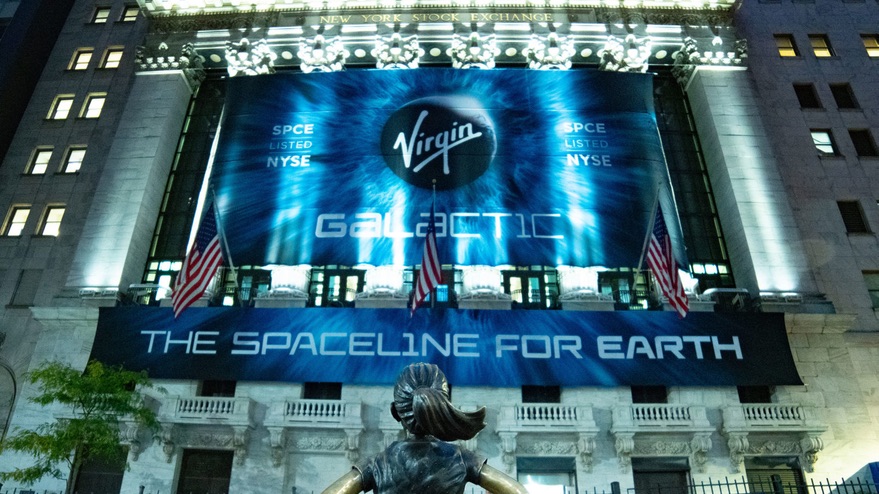Virgin Galactic keeps long-term focus as shares make public debut

WASHINGTON — Shares in suborbital spaceflight company Virgin Galactic were flat in their first day of trading as company leadership says that they will retain a long-term mindset despite now being a public company.
Virgin Galactic stock closed at $11.75 per share in its first day of trading Oct. 28 on the New York Stock Exchange, down four cents. Shares soared in the early hours of trading, at one point up nearly 10%, but the price declined gradually as the day went on.
Virgin Galactic’s debut on the public markets included an appearance by company founder Sir Richard Branson on the floor of the exchange, wearing the blue flight suit the company unveiled earlier this month that will be worn by its suborbital spaceflight customers. The outside of the stock exchange building was wrapped in Virgin Galactic logos, and there were even pyrotechnics inside and outside the exchange to mark the start of public trading.
“It was all sort of surreal, but very exciting,” said George Whitesides, chief executive of Virgin Galactic, in an interview several hours after the stock’s debut.
Virgin Galactic went public not through a traditional initial public offering of stock but instead by merging with Social Capital Hedosophia (SCH), a special-purpose acquisition company whose stock was already trading on the exchange. Shares in SCH, which traded under the ticker symbol IPOA, closed up more than 11% on Oct. 25, the day the merger with Virgin Galactic closed. The stock now trades under the ticker symbol SPCE as Virgin Galactic Holdings.
The merger not only made Virgin Galactic a publicly traded company but also provided it with more than $450 million in capital it will use to fund its shift from development into operations. Whitesides said that the merger doesn’t otherwise make many changes in the company.
“We’re sort of supercharged towards the same goals: getting into commercial operation, building our next spaceships,” he said. “But they’re the same goals. We’re not changing radically.”
Being a public company, though, will generate new scrutiny on the company, which will now have to file quarterly reports and make other public disclosures of its finances and operations. That doesn’t mean a shift towards short-term thinking at the company, Whitesides argued.
“I’m think we’ve been lucky to get some really good long-term shareholders,” he said. “Those are folks who are excited about the mid- to long-term potential of the company. Hopefully they’ll be encouraging us to pay attention to the right things.”
Going public will have other benefits. Employees will now have access to stock options, he said, while the general public can now own a part of a “pure-play” commercial space company.
Besides making Virgin Galactic publicly traded, the merger also unlocked an investment agreement with Boeing announced Oct. 8. Boeing HorizonX Ventures, the company’s venture capital arm, will invest $20 million in Virgin Galactic. The two companies will collaborate “to broaden commercial space access and transform global travel technologies,” they said in a statement announcing the deal.
Speculation about the deal has focused on high-speed point-to-point transportation, an area Virgin Galactic has stated in investment presentations is part of the company’s long-term vision. But Whitesides said the two companies are interested in collaborating in more than that.
“They’re interested in different things, and so are we,” he said. “I definitely believe high-speed mobility will be the main focus of that, but I think we’ll look at a few different areas and see what things are the most interesting and where we might be able to make some progress.”
For now, Virgin Galactic is completing what Whitesides called the “final batch of work” on its first operational SpaceShipTwo vehicle, VSS Unity. That vehicle will go late this year from Mojave Air and Space Port in California to Spaceport America in New Mexico for a final series of test flights before beginning commercial operations by the middle of 2020.
Virgin Galactic has a little more than 600 customers signed up, and Whitesides said the company is preparing to resume ticket sales, which had been frozen for the last few years. He said more than 3,700 people “have expressed a desire to buy a ticket” since the company’s first flight to the edge of space in December 2018. “We’re getting close” to resuming ticket sales, he said, as the company finalizes a new pricing strategy.
Related
ncG1vNJzZmiroJawprrEsKpnm5%2BifLe10aCgp2WXlrmir9OimmajlZq9tHnLqKWgZaSav655xaiarqtdlsBuv8eaqZ6rXaKurLGMqaybpJmYeqWxwa6raA%3D%3D